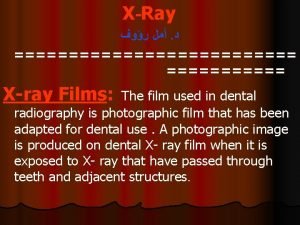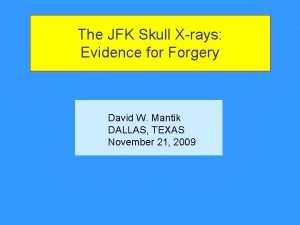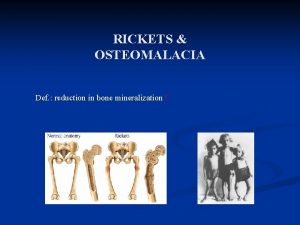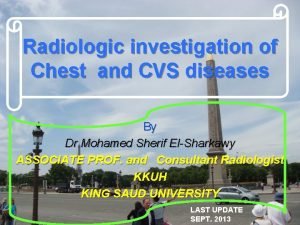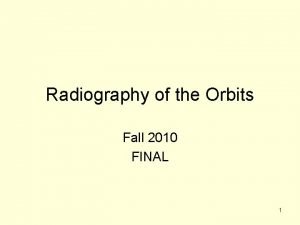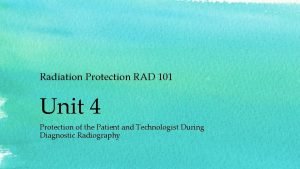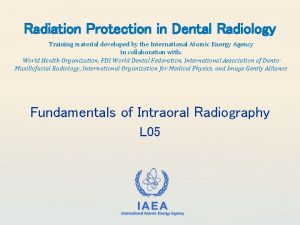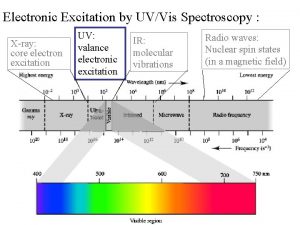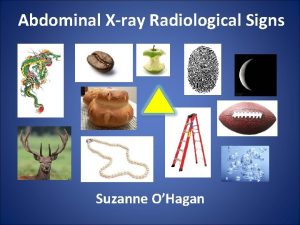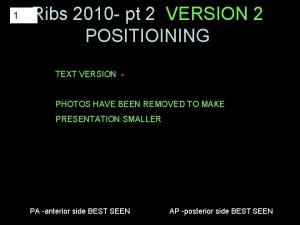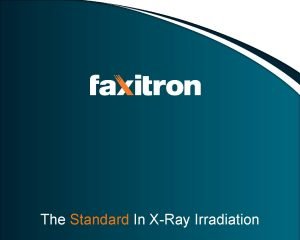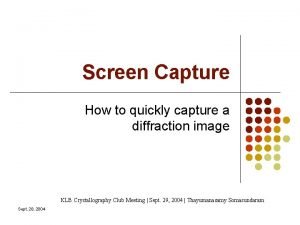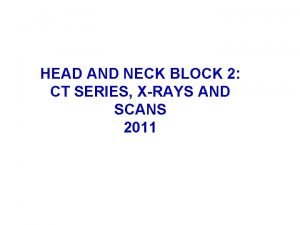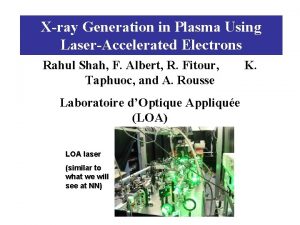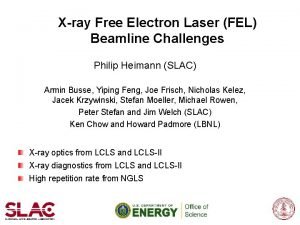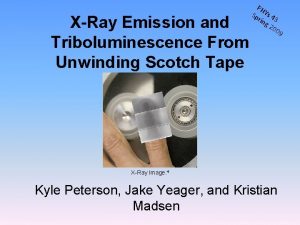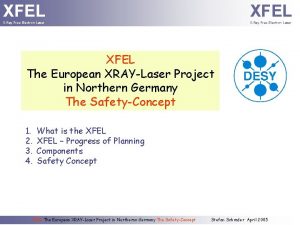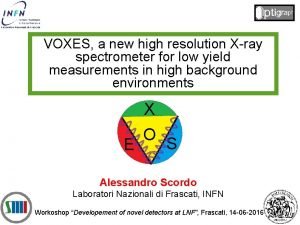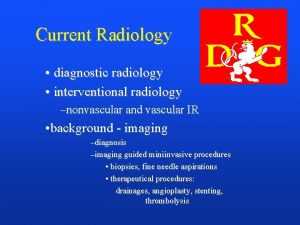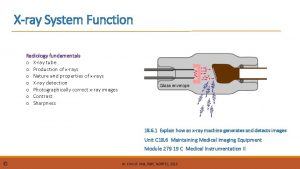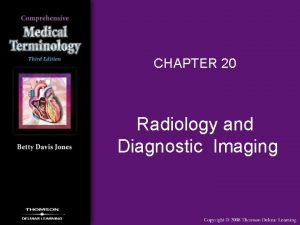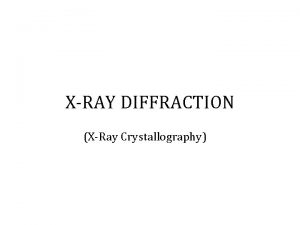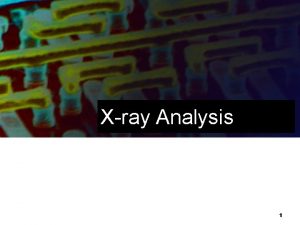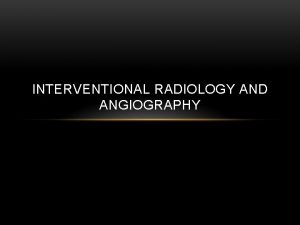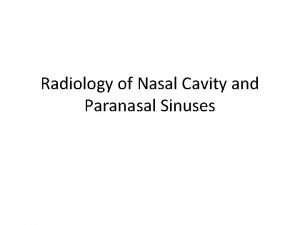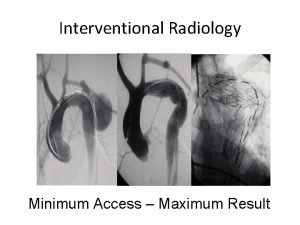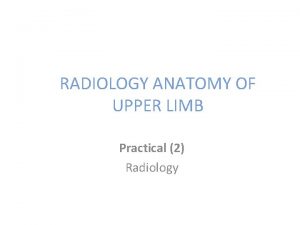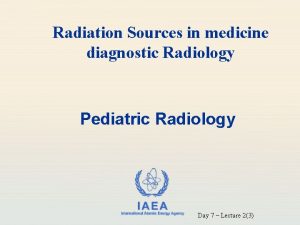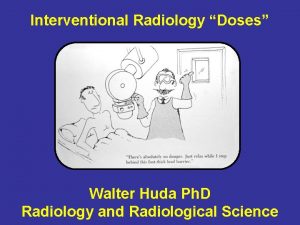Chapter 1 9 History of Radiology and Xray
































- Slides: 32

Chapter 1 & 9 History of Radiology and X-ray Tube

Timeline of Radiology 1895 - Roentgen’s discoveries X-ray or Roentgen rays. 1896 -Thomas Edison developed the first fluoroscope 1896 - first reported case of biological damage 1921 Potter-Bucky grid was introduced

Timeline � 1942 first AEC was demonstrated � 1942 first automatic processor developed � 1986 -1974 cassettes calcium tungstate screen � 1970 Intensifying screens � 1979 First digital

Timeline � 1982 PACS Picture Archiving & Communications Systems ( storage & access of digital images) � 1982 Teleradiolgy � 1980 s CR Computed Radiography (cassette converting images to electronic signal and stored in a computer (filmless)

Timeline � 1996 DR direct digital image is directly captured by electronic elements with no intermediate step ( cassettesless)

Important facts Natural Radiation �¾ of all radiation we receive comes from nature rather than technology ◦ ◦ Minerals in ground ( Terrestrial) Cosmic Internal Radon

Manmade Radiation/Other � Medical x-rays � Nuclear medicine � Consumer products � Fallout � Occupational

ALARA � As Low As Reasonably Achievable � X-ray profession is a safe profession

Background of Radiology � Discovery of x-ray. November 8, 1895 by Wilhelm Conrad Roentgen in Germany

First x-ray Roentgen’s wife's hand

X-ray Tubes � Crooke’s � Jackson Tube Focus Tube � Coolidge Hot Cathode

Modern x-ray tube

Modern x-ray tube � Consists of the following: ◦ Highly evacuated glass tube ◦ Two sealed electrodes, Cathode and Anode • Cathode- negative electrode, source of electrons • Anode - positive electrode, source of radiation (x-rays)

Cathode negatively charged � Contains a spiral, incandescent filament of tungsten wire � Filament is heated by an electrical current of low amperage from a transformer � Temperature of the filament, controlled by the amount of current passing through it, controls the number of electrons emitted

Cathode � Filament ◦ Source of electrons �Filament current �Thermionic emission ◦ Coiled tungsten wire �Large and small ◦ Focusing cup �Space charge effect

Thermionic Electron Emission � Another reason for the high melting point of tungsten is that the filament gets so hot it actually glows. This glowing is called incandescence. And the process is known as thermionic emission. � When the filaments gets that hot it the electrons are “boiled off” or freed from the atoms.

Current � Higher the temperature of the filament, the more electrons emitted � Direct relationship � Stream of electrons from cathode to anode is known as the tube current � Current is measured in milliamperes (m. A) � Stream of electrons are taken from cathode to anode by a transformer (k. Vp) ◦ The speed with which the electrons cross the gap between the cathode and the anode.

Anode � Two types ◦ Stationary- could be melted from the intense bombardment of electrons. ◦ Rotating- composed of metal with a good heat conducting characteristics (molybdenum) �Disc shaped anode is coated with an alloy made of tungsten and rhenium

Anode � Rotating anode ◦ Requires a stator and rotor to rotate ◦ Tungsten metal �High melting point �Efficient x-ray production ◦ Target �Decelerates and stops electrons �Energy converted to heat and x-rays �Bremsstrahlung and characteristic interactions

Producing X-rays � Voltage kicks in, takes electrons across the tube � Thermionic Emission is a boiling off effect, electrons move by heat raising the temperature and the electrons boil off the filament � Voltage is then responsible for taking the electrons across the tube to the anode (k. Vp)

Producing X-rays � Anode is made of tungsten and rhenium because they have high melting points � Anode needs to slow down or stop the electrons � Once electrons reach the anode they become photons � Each photon accounts for one x-ray

Review � Who invented x-rays? � What year were x-rays invented? � What was the name of the first tube used when x-rays were invented? � What was the problem with the first x-ray tube? � What was the problem with the second x-ray tube?

What are x-rays? � X-ray production is the striking of matter by high speed electrons. � X-rays are generated in x-ray tube � form of electromagnetic radiation � Form of invisible radiant energy � Have short wavelengths; gives x-rays ability to penetrate materials that would normally reflect or absorb light

Behaviors of x-rays � Two behaviors: Waves and Particles � Have shorter wavelengths than regular light � Consist of small bundles of energy called photons � Wavelength vs. k. Vp � as k. Vp is increased, the wavelength of x-rays decreases; indirect relationship

X-rays as Energy �A form of electromagnetic radiation � Behave both like waves and like particles � Move in waves that have wavelength and frequency � Wavelength and frequency are inversely related � X-rays also behave like particles and move as photons

Properties of x-rays � Can penetrate materials that normally absorb or reflect light due to short wavelengths � Cause certain objects to fluoresce- ability to emit natural light. � Ability to penetrate solid and opaque materials to produce an image � X-rays are invisible

Properties of x-rays � Can produce biological changes that can stimulate or retard growth � X-rays travel in straight lines � Travel at the speed of light ( 186, 000 miles per second) � Ionize gases by removing electrons from atoms to form ions ( negatively charged atoms)

Features of X-ray Tube � All x-ray tubes are a vacuums, free of air, air impedes the flow of electrons � X-rays are produced when energy is changed from one ion to another � Cathode is negatively charged source of electrons � Anode positively charged source of electrons

Features of X-ray Tube � Anode minute spins 3400 & 10, 000 revolutions per � Spinning the anode, prevents the same spot on the anode from being hit by the stream of electrons � Exposure exposure � Rotor- switch- two functions: rotor and activates the anode to begin spinning

Features of X-ray Tube � Rotor also activates the electrons on the cathode to begin to group and form on the tungsten filament � Exposure switch- releases the electrons to be propelled from the cathode to the target of the anode and x-rays are produced

m. As and k. Vp � m. As (milliampere quantity) controls the amount of radiation that will be produced. � m. As � k. Vp supplies the current to the cathode (kilovoltage peak)(quality) is the voltage, penetrating ability, power, strength of the electrons traveling across the cathode to the anode.

X-ray Production � The production of x-rays requires a rapidly moving stream of electrons that are suddenly decelerated or stopped. ◦ The negative electrode (cathode) is heated, and electrons are emitted (thermionic emission). ◦ The electrons are attracted to the anode, move rapidly towards the positive electrode, and are stopped or decelerated.
 Dental radiology ppt
Dental radiology ppt Waters view with open mouth
Waters view with open mouth The label side of the dental film packet
The label side of the dental film packet Kub xray
Kub xray Xray xml editor
Xray xml editor Sza xray
Sza xray Jfk xray
Jfk xray Mary beth sanders
Mary beth sanders Rickets diagnosis
Rickets diagnosis Pulmonary embolism cxr
Pulmonary embolism cxr Rhese method rheese orbits positioning
Rhese method rheese orbits positioning Petrous pyramid skull
Petrous pyramid skull Xray technique chart
Xray technique chart Bitewing periapical
Bitewing periapical Xray circuit
Xray circuit Xray lara
Xray lara Double exposure xray
Double exposure xray Double bond extending conjugation
Double bond extending conjugation 5 cyanotic congenital heart disease
5 cyanotic congenital heart disease Lightbulb xray
Lightbulb xray Noi poi doi toi
Noi poi doi toi Projection
Projection Xray file cabinet
Xray file cabinet Gimp xray
Gimp xray Maze type entrance
Maze type entrance Hampton hump sign
Hampton hump sign First xray ever taken
First xray ever taken Pterigoid plate
Pterigoid plate Xray laser
Xray laser Xray laser
Xray laser Scotch tape x ray
Scotch tape x ray Xray laser
Xray laser Xray spectrometer
Xray spectrometer


